If you’re a subscriber to the Buzz, thank you! If you’re new here, or you haven’t become a subscriber yet, hit that subscribe button to have History Buzz delivered directly to your inbox. If you can, please consider a paid subscription to support the research and writing that make History Buzz possible.
On December 10, 1956, a group of 150 business and community leaders met at the Andover Inn. An announcement was made that Sylvania Electric Products and Corning Glass works would pair up and construct an atomic energy center on a 150-acre site in West Andover. The center would concentrate on the construction of nuclear fuel elements. Walter E. Kingston, a top manager at Sylvania, declared that the new energy center “will be the outstanding type of its facility in the world”. Another Sylvania bigwig (with a name to match), W. Benton Harrison, described a “sort of filling station for atomic reactors, wherever they may be.” It was emphasized that there would be no risk of exposure to radioactivity. Phew!
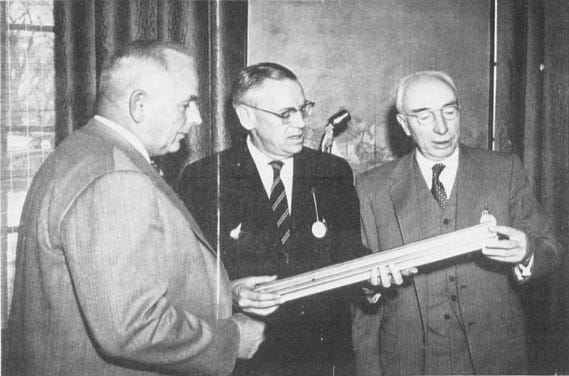
When I first encountered this story, I had mixed feelings. I am in favor of nuclear power. But I remembered a camp counselor warning us of dire consequences if an accident happened at the nuclear power plant in Seabrook. I was in my teens by then, and the merit badge was in emergency preparedness.
It was the headlines that grabbed my attention. “Andover Hails Nuclear Plant” screamed the Andover Townsman’s front page on December 13. The coverage goes on to explain much more about the facility. Sylvania-Corning was well-pleased with Andover. Kingston explained that Andover possessed several prerequisites required by the industry like good transportation, public utilities, and a fine public health and safety record. Then he really turns on the charm and praises Andover townspeople for being “intelligent, alert, and progressive minded”. Competition was stiff. Fifty other locations were considered, many of them in the Boston area.

Scheduled to open in 1958, the plant would initially employ 300 people spread out among five buildings. One third of those employees would be engineers and professionally-trained personnel. Eventually, the plant would provide jobs for 1,000 employees, mostly skilled craftsmen from the Andover area. “The buildings will include facilities for manufacturing, pilot production, advanced engineering, sales, and administration, built in a campus-style arrangement and landscaped.”
Sylvania-Corning optioned 150 acres of the Shattuck farm by the river. Land belonging to the Webb farm was also included in the site. My historical GPS is confused by ‘New Route 28’.
Catherine Shattuck, owner of the Shattuck property along the Merrimack, told the Daily Boston Globe that “This is progress. I am not going to stand in the way of it.” The Globe’s real estate editor made it a point to mention that Shattuck signed the option while inside her 200-year old farm house. Oh, by the way, John T. Fallon was said to have worked a 36-hour day to close the deal.
"This machine, capable of exerting 150 tons of pressure, is used to shape atomic fuel elements at a Sylvania Atomic Energy Division facility . Similar Machinery presumably will be used in the Sylvania-Corning Plant here. An atomic fuel plate is being placed prior to shaping by the ‘power brake’. There are many fuel-element shapes, depending upon the type of reactor for which they have been designed. After shaping, fuel plates are assembled to form the final fuel element"
As we know today, Andover’s “filling station for atomic reactors” was never built. Everything about this story suggests that Sylvania-Corning wanted to move at warp speed in 1956. Why? Harrison stated that “during the next four years, between $300 million and $350 million will be spent by industry and other private, non-governmental organizations on atoms-for-peace projects.” He predicted that, by 1980, nuclear power would account for 20 percent of the generating capacity in the United States. William Webster, another important figure in the business said that “some day most of the fuel required for electric plants will come from atomic energy.”
Webster was president of the Yankee Atomic Electric Company, operators of the nuclear power plant located on the Massachusetts-Vermont border. He believed that New England could benefit from industries that would emerge as atomic energy became widespread. Fuel for reactors had to be fabricated, instruments and controls for the reactors needed to be created, spent fuel had to be re-processed, and research had to continue.
The optimism here in Andover faded quickly. By the summer of 1957, rumor had it that Sylvania-Corning was looking elsewhere. The August 22 issue of the Townsman reported on a letter sent by Dr. Lee Davenport, head of the company, to the selectmen. He wrote that “‘important developments’ have occurred within the past week.” More time was needed to evaluate those developments and company officials would meet with Andover selectmen “sometime in late September.” Davenport stressed that Sylvania-Corning was not abandoning Andover. If I was reading the Townsman in 1957, I would have been skeptical.
Andover’s atomic energy plant was called off in November of 1957. The forecasts made the previous year proved to be too rosy. Sylvania-Corning’s cancellation notice cited increased competition in the nuclear power industry, cut-backs in government projects, a failure to develop peacetime uses for atomic energy, and more favorable regulations in other countries.
Nor could atomic energy get too big too fast “[M]ost of the industry's work in the foreseeable future must be done in facilities that are basically developmental laboratories or comparatively small production plants closely allied with those laboratories."
As of November, 2023, 93 nuclear reactors were operating in the United States. Nuclear power is on the decline in this country. Some reactors are not being used for their full operational life. The World Nuclear Association reports that “Early closures have been brought on by a combination of factors including cheap natural gas, market liberalization, over-subsidy of renewable resources, and political campaigning.”
The Shattuck and Webb Farms are both gone, replaced by Philips healthcare, the medical technology company Smith+Nephew, and other businesses. Even though we are not supporting reactors, science and technology has found a home in Andover. Atomic energy has its uses in healthcare, don’t you know.
I’m something of a Clash fan, so the title of this post is inspired by London Calling.
Thanks for reading! Do you recall this story? Leave us a comment. We’d love to hear form you!
~Doug
Further Reading:
Andover Townsman December 13, 1956. Available online: https://mhl.org/sites/default/files/newspapers/ATM-1956-12-13.pdf (last accessed December 24, 2023)
$5 Million Andover Atomic Center Will Be Best of Kind in World. Daily Boston Globe December 11, 1956
$20 Million Nuclear Plant For Andover Called Off. Daily Boston Globe November 5, 1957
CORNER STAND: "This Is Progress--I Am Not Going to Stand in the Way.. ". Daily Boston Globe December 16, 1956
N. E. to Bask in Atomic Energy's Rays. Daily Boston Globe. July 27, 1958
World Nuclear Association. Nuclear Power in the World Today. http://tinyurl.com/3yfte3fu (last accessed December 29, 2023)
Farhad Manjoo. Nuclear Power Still Doesn’t Make Much Sense. New York Times. September 16, 2022. https://www.nytimes.com/2022/09/16/opinion/nuclear-power-still-doesnt-make-much-sense.html (last accessed December 28, 2023)
Sylvania-Corning Drops Option In W. Andover. Andover Townsman November 7, 1957. Available online: https://mhl.org/sites/default/files/newspapers/ATM-1957-11-07.pdf (last Accessed December 24, 2023)





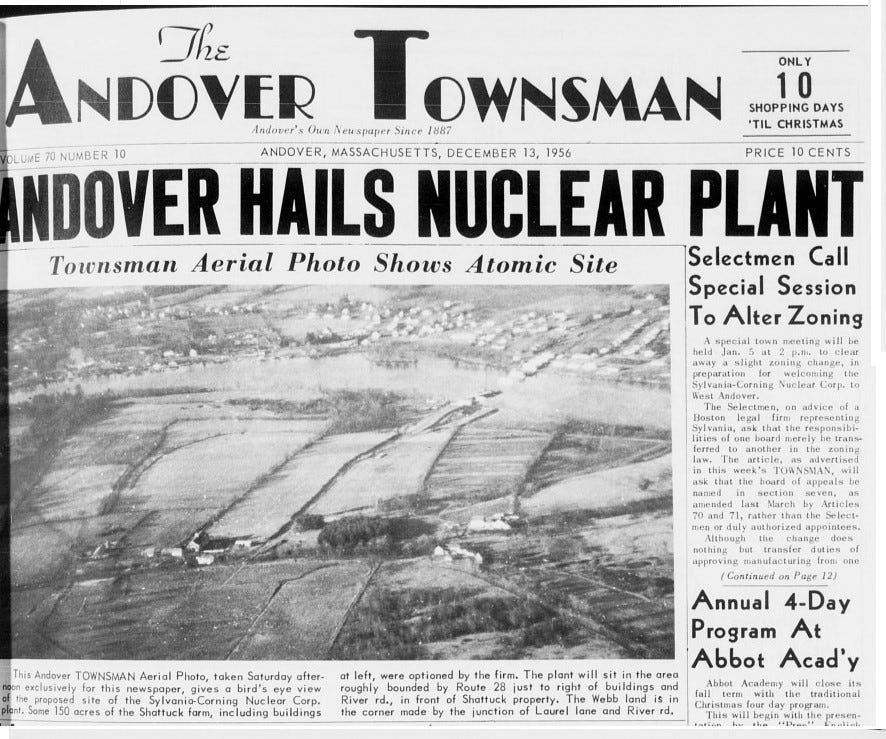
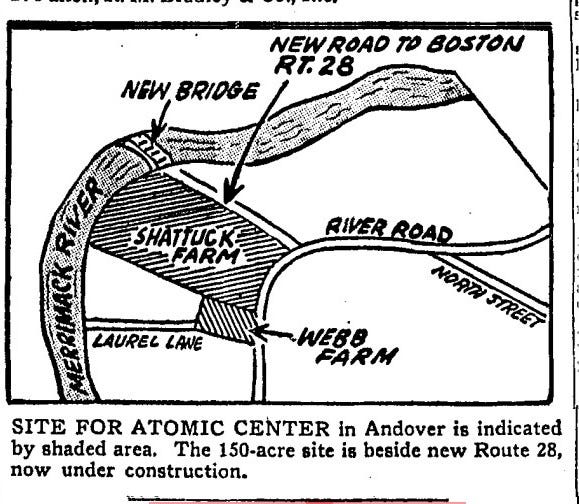
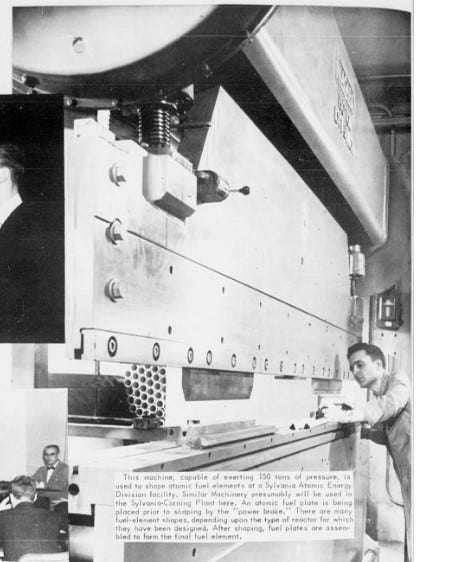
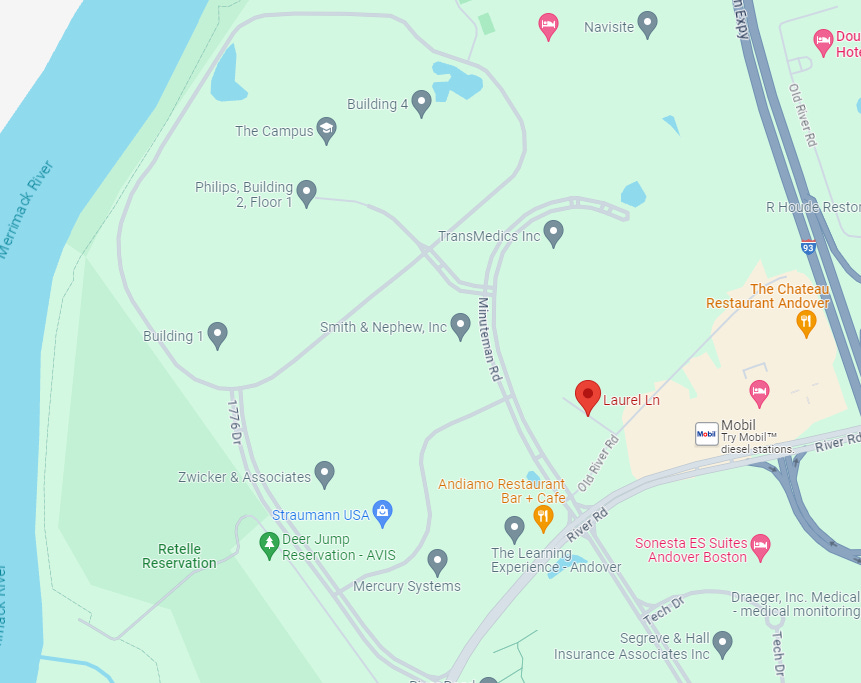
Nice work Doug. I do remember this as I was in elementary school at the time. Route 93 was under construction at that time and was referred to as the New Route 28, which runs parallel to our old Route 28 Main St. from Boston to Concord NH.
This plan, I am sure, would not have been a slam dunk for Andover residents who would have to approve the re-zoning. Air raid attack warnings and drills at school were done if we were under a nuclear attack. This was scary stuff to kids in school at that time. We did not duck under our desks but went out in the hall, sat down in front of our locker, knees up, heads down and waited until the siren stopped which was located right behind the West Elem. School. To add to the heighten tension was the plan to locate a missile silo in North Andover.
I was only 9 at the time of this announcement and issue. The "New Route 28" caught my attention as I remember Route 93 being built. Didn't know it was called by the old route number. In the 1970's the Shattuck family had passed on and left some items to the historical society. As president at the time, I had to go to the old house and meet the lawyer to pick them up.